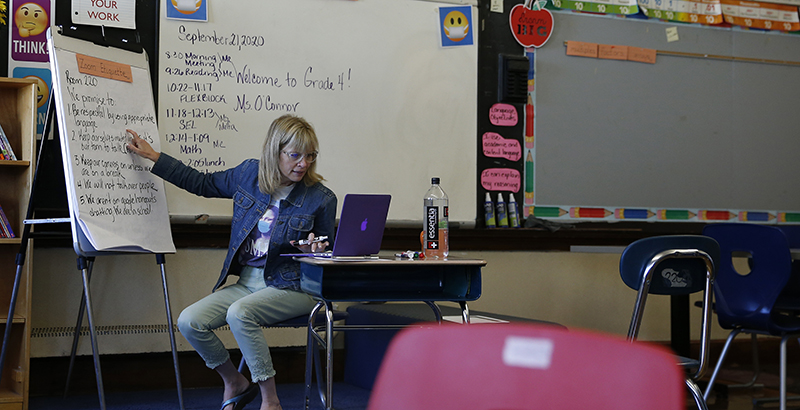Dobard: Educational Innovation Isn’t Just the Technology, It’s the Teaching. How Educators Are Getting Creative in the Pandemic

Education requires innovation. During a pandemic, that innovation is all the more urgent. But much of that innovation does not get written about in Wired. It doesn’t involve technology at all. Rather, it involves educators doing one of the hardest jobs in the world during a stunningly difficult time. They are continuing to teach using high-quality curriculum, pushing academic rigor, addressing learning loss from last spring and summer, and supporting students emotionally. Put simply, they are innovators.
Innovation is a science teacher preparing for her virtual lessons with handwritten notes, then wheeling a whiteboard into her living room across from her web camera for class. It’s using decades of experience to bring the classroom alive through a computer screen — not with technological bells and whistles, but by truly getting to know students and employing time-tested pedagogical techniques to keep them engaged and learning.
Innovation is organizing a drive-through graduation or a student-by-student ceremony when students and families cannot gather in person. Schools across New Orleans found innovative ways to make sure their graduates felt celebrated last spring and summer. One even held individual graduation ceremonies for every student, so their families could come while social distance and crowd-size limits were maintained.
Innovation is finding ways to address trauma and meet social-emotional needs online through family webinars, Zoom dance parties or a mental health hotline. It is supporting children through the continued, devastating racist violence in our nation by building empowering, loving environments and using trauma-informed, restorative disciplinary practices.
Innovation is a homeroom teacher realizing that one student’s plan to bake his grandfather a cake could be a classwide bonding opportunity. Knowing that students thrive when they feel connected and cared for as part of a community, the teacher used this as an opportunity to build that connection by narrating the action as the fifth-grader moved about his kitchen on Zoom, while classmates gave feedback.
Innovation is a principal knowing that singing the same song at assembly each morning energized students in years past — so with assemblies off-limits this year, she decided to play it over the loudspeaker each day into their socially distanced classrooms. The song, “Something Inside So Strong,” reminds students that they are powerful and can surmount obstacles in their way.
The logistics that teachers and paraprofessionals are called to manage right now are astonishing. Some are simultaneously teaching virtual and in-person classes. Others are supporting a classroom of students who stay together all day but plug in to different classes from their own computers. Many are teaching from their own homes, with their children attending school just a few feet away.
Across grade levels and environments, educators have had to innovate to connect their students to a whole new set of protocols. How does a teacher get a group of 6-year-olds to stay 6 feet apart in the hallway? In some schools, with space markers shaped like hearts and butterflies. How can preschool and kindergarten teachers find ways to preserve educational play during a pandemic? In one school’s case, by partnering with a children’s museum. How does a high school make sure students’ social-emotional and academic needs are met? By using study hall time for personal check-ins as well as homework support. These are questions that none of us expected to have to ask, but our schools are finding answers to.
New Schools for New Orleans, the organization I lead, has witnessed some of this innovation firsthand through our relationships with schools and educators. We fund collaboratives in which teachers receive professional development, with special focuses on students with disabilities and English learners, science and technology training. In these collaboratives, teachers come together to learn from experts and one another. They figure out how they will mold the best practices into their own classroom. That, too, is innovation.
There are countless such moments of innovation from educators that go noticed and unnoticed each day. Teachers are experts, and they have been innovating in their classrooms since long before this crisis. As we continue to ask what to do about schooling in this pandemic, and how best to educate our children, we should look to them.
Patrick Dobard is CEO of New Schools for New Orleans and former Recovery School District superintendent.
Get stories like these delivered straight to your inbox. Sign up for The 74 Newsletter

;)